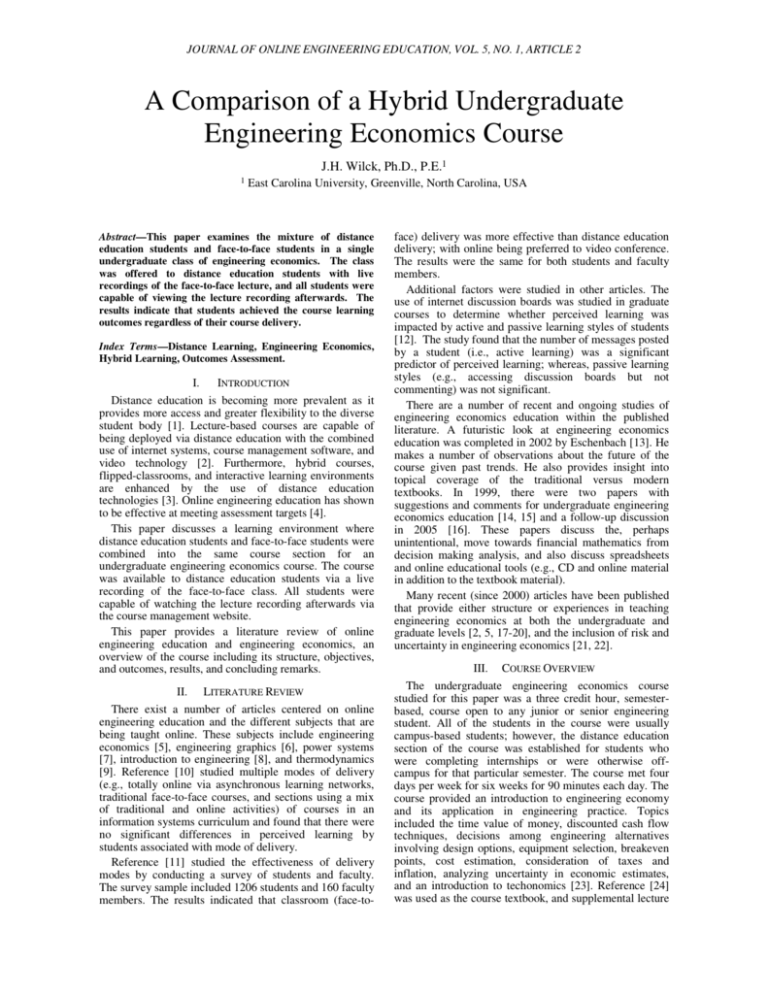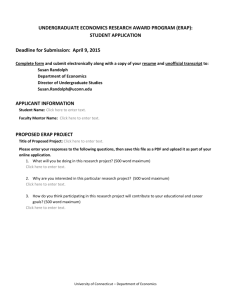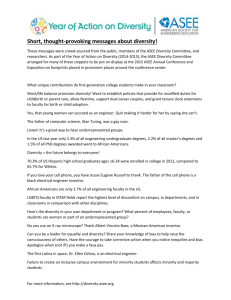A Comparison of a Hybrid Undergraduate Engineering Economics
advertisement

JOURNAL OF ONLINE ENGINEERING EDUCATION, VOL. 5, NO. 1, ARTICLE 2 A Comparison of a Hybrid Undergraduate Engineering Economics Course J.H. Wilck, Ph.D., P.E.1 1 East Carolina University, Greenville, North Carolina, USA Abstract—This paper examines the mixture of distance education students and face-to-face students in a single undergraduate class of engineering economics. The class was offered to distance education students with live recordings of the face-to-face lecture, and all students were capable of viewing the lecture recording afterwards. The results indicate that students achieved the course learning outcomes regardless of their course delivery. Index Terms—Distance Learning, Engineering Economics, Hybrid Learning, Outcomes Assessment. I. INTRODUCTION Distance education is becoming more prevalent as it provides more access and greater flexibility to the diverse student body [1]. Lecture-based courses are capable of being deployed via distance education with the combined use of internet systems, course management software, and video technology [2]. Furthermore, hybrid courses, flipped-classrooms, and interactive learning environments are enhanced by the use of distance education technologies [3]. Online engineering education has shown to be effective at meeting assessment targets [4]. This paper discusses a learning environment where distance education students and face-to-face students were combined into the same course section for an undergraduate engineering economics course. The course was available to distance education students via a live recording of the face-to-face class. All students were capable of watching the lecture recording afterwards via the course management website. This paper provides a literature review of online engineering education and engineering economics, an overview of the course including its structure, objectives, and outcomes, results, and concluding remarks. II. LITERATURE REVIEW There exist a number of articles centered on online engineering education and the different subjects that are being taught online. These subjects include engineering economics [5], engineering graphics [6], power systems [7], introduction to engineering [8], and thermodynamics [9]. Reference [10] studied multiple modes of delivery (e.g., totally online via asynchronous learning networks, traditional face-to-face courses, and sections using a mix of traditional and online activities) of courses in an information systems curriculum and found that there were no significant differences in perceived learning by students associated with mode of delivery. Reference [11] studied the effectiveness of delivery modes by conducting a survey of students and faculty. The survey sample included 1206 students and 160 faculty members. The results indicated that classroom (face-to- face) delivery was more effective than distance education delivery; with online being preferred to video conference. The results were the same for both students and faculty members. Additional factors were studied in other articles. The use of internet discussion boards was studied in graduate courses to determine whether perceived learning was impacted by active and passive learning styles of students [12]. The study found that the number of messages posted by a student (i.e., active learning) was a significant predictor of perceived learning; whereas, passive learning styles (e.g., accessing discussion boards but not commenting) was not significant. There are a number of recent and ongoing studies of engineering economics education within the published literature. A futuristic look at engineering economics education was completed in 2002 by Eschenbach [13]. He makes a number of observations about the future of the course given past trends. He also provides insight into topical coverage of the traditional versus modern textbooks. In 1999, there were two papers with suggestions and comments for undergraduate engineering economics education [14, 15] and a follow-up discussion in 2005 [16]. These papers discuss the, perhaps unintentional, move towards financial mathematics from decision making analysis, and also discuss spreadsheets and online educational tools (e.g., CD and online material in addition to the textbook material). Many recent (since 2000) articles have been published that provide either structure or experiences in teaching engineering economics at both the undergraduate and graduate levels [2, 5, 17-20], and the inclusion of risk and uncertainty in engineering economics [21, 22]. III. COURSE OVERVIEW The undergraduate engineering economics course studied for this paper was a three credit hour, semesterbased, course open to any junior or senior engineering student. All of the students in the course were usually campus-based students; however, the distance education section of the course was established for students who were completing internships or were otherwise offcampus for that particular semester. The course met four days per week for six weeks for 90 minutes each day. The course provided an introduction to engineering economy and its application in engineering practice. Topics included the time value of money, discounted cash flow techniques, decisions among engineering alternatives involving design options, equipment selection, breakeven points, cost estimation, consideration of taxes and inflation, analyzing uncertainty in economic estimates, and an introduction to techonomics [23]. Reference [24] was used as the course textbook, and supplemental lecture JOURNAL OF ONLINE ENGINEERING EDUCATION, VOL. 5, NO. 1, ARTICLE 2 notes were provided by the instructor via the course management website. The course learning outcomes are, upon successful completion of the course, the student should be able to: 1. Evaluate discounted cash flow (e.g., equivalence, PW, equivalent annual FW, rate of return) problems 2. Evaluate cost (e.g., incremental, average, sunk, estimating) problems 3. Evaluate types and breakdown of costs (e.g., fixed, variable, direct and indirect labor, material, capitalized) problems 4. Complete analyses (e.g., breakeven, benefitcost) 5. Evaluate alternatives involving uncertainty (e.g., expected value and risk) 6. Complete basic accounting (e.g., financial statements and overhead cost allocation) problems 7. Develop cost estimates 8. Evaluate alternatives using depreciation and taxes 9. Complete capital budgeting problems IV. RESULTS The course learning outcomes were assessed using both direct and indirect measures. The course learning objectives were assessed for each student using assignments (e.g., homework and examinations); thus, the performances on these assignments were used as direct measures for the course learning outcomes. Surveys distributed to students at the end of the course were used as an indirect assessment of the course learning outcomes, as well as additional questions regarding other issues (e.g., instructor effectiveness, textbook effectiveness). Table I shows the results of the direct assessment for the distance education students; whereas, Table II shows the direct assessment for the face-to-face students. The target for each item was a 70% mean for a specific assignment problem. This was a standard set by the department’s curriculum committee and was standard throughout the department for assessment purposes. Based on results, the course learning outcomes were achieved at or exceeding the target level. The indirect assessment completed by the students is not aggregated between distance education and face-toface students. Thus, Table III shows the results of survey for all students participating in the course. The scale for the survey was 1 to 5, with 5 being “Strongly Agree,” 4 being “Agree,” 3 being “Neutral,” 2 being “Disagree,” and 1 being “Strongly Disagree.” The results indicate that the students felt that they met the course learning outcomes. TABLE I. DIRECT ASSESSMENT OF COURSE LEARNING OUTCOMES FOR DISTANCE EDUCATION STUDENTS Target Met A1, Q1 100.0% 70.6% 68.0% 36.0% Yes A1, Q2 100.0% 98.5% 100.0% 84.0% Yes A1, Q3 100.0% 93.5% 76.0% 76.0% Yes A1, Q4 100.0% 74.5% 60.0% 20.0% Yes A1, Q5 100.0% 73.2% 76.0% 52.0% Yes A1, Q6 100.0% 90.5% 100.0% 52.0% Yes A2, Q1 100.0% 93.8% 100.0% 76.0% Yes A2, Q2 100.0% 81.2% 76.0% 20.0% Yes A2, Q3 100.0% 80.6% 100.0% 37.5% Yes A3, Q1 100.0% 78.6% 100.0% 0.0% Yes A3, Q2 100.0% 75.4% 100.0% 37.5% Yes A3, Q3 100.0% 70.2% 75.0% 37.5% Yes A3, Q7 100.0% 80.6% 100.0% 50.0% Yes A3, Q8 100.0% 83.1% 100.0% 50.0% Yes A4, Q1 100.0% 81.9% 100.0% 0.0% Yes A4, Q2 100.0% 85.7% 100.0% 16.7% Yes A5, Q3 100.0% 74.2% 66.7% 0.0% Yes A5, Q4 100.0% 90.9% 100.0% 66.7% Yes A6, Q2 100.0% 75.0% 66.7% 50.0% Yes A6, Q3 100.0% 81.2% 91.7% 0.0% Yes Course Learning Outcome Acheivement (Y/N)? Assignment Maximum Mean Median Minimum Course Learning Outcome 1 2 3 4 5 6 7 8 9 X X X X X X X X X X X X X X X X X X X X Y Y Y Y Y Y Y Y Y TABLE II. DIRECT ASSESSMENT OF COURSE LEARNING OUTCOMES FOR FACE-TOFACE STUDENTS Target Met A1, Q1 100.0% 71.9% 67.7% 36.1% Yes A1, Q2 100.0% 96.5% 98.5% 83.0% Yes A1, Q3 100.0% 93.1% 74.8% 76.6% Yes A1, Q4 100.0% 76.4% 61.7% 15.0% Yes A1, Q5 100.0% 74.7% 75.4% 50.0% Yes A1, Q6 100.0% 88.6% 100.0% 60.0% Yes A2, Q1 100.0% 92.8% 100.0% 80.0% Yes A2, Q2 100.0% 82.4% 76.6% 20.0% Yes A2, Q3 100.0% 79.0% 98.1% 37.5% Yes A3, Q1 100.0% 77.9% 98.8% 0.0% Yes A3, Q2 100.0% 76.9% 98.1% 50.0% Yes A3, Q3 100.0% 68.6% 75.5% 0.0% Yes A3, Q7 100.0% 81.5% 100.0% 50.0% Yes A3, Q8 100.0% 81.7% 98.7% 50.0% Yes A4, Q1 100.0% 82.1% 100.0% 0.0% Yes A4, Q2 100.0% 86.7% 100.0% 16.7% Yes A5, Q3 100.0% 73.9% 66.7% 0.0% Yes A5, Q4 100.0% 90.5% 98.4% 66.7% Yes A6, Q2 100.0% 76.0% 66.6% 50.0% Yes A6, Q3 100.0% 82.9% 91.7% 0.0% Yes Course Learning Outcome Acheivement (Y/N)? Assignment Maximum Mean Median Minimum Course Learning Outcome 1 2 3 4 5 6 7 8 9 X X X X X X X X X X X X X X X X X X X X Y Y Y Y Y Y Y Y Y TABLE III. INDIRECT ASSESSMENT OF COURSE LEARNING OUTCOMES Question I am able to evaluate discounted cash flow problems. I am able to evaluate cost problems. I am able to evaluate types and breakdown of costs problems. I am able to complete breakeven and benefit-cost analyses. I am able to evaluate alternatives involving uncertainty. I am able to complete basic accounting problems. I am able to develop cost estimates. I am able to evaluate alternatives using depreciation and taxes. I am able to complete capital budgeting problems. Mean 3.96/5.00 4.15/5.00 4.08/5.00 4.14/5.00 4.17/5.00 4.20/5.00 4.04/5.00 3.75/5.00 4.11/5.00 Median 4.0/5.0 4.0/5.0 4.0/5.0 4.0/5.0 4.0/5.0 4.0/5.0 4.0/5.0 4.0/5.0 4.0/5.0 V. DISCUSSION AND CONCLUSIONS The results from Table I and Table II show that both distance education students and face-to-face students achieved the course learning outcomes for the undergraduate engineering economics course. The difference between the two groups of students was JOURNAL OF ONLINE ENGINEERING EDUCATION, VOL. 5, NO. 1, ARTICLE 2 minimal (insignificant) on a question-by-question basis; which indicates that both types of students achieved the outcomes at the same level of aspiration. The results from Table III show that the students felt that they learned the material and achieved the outcomes. The results and achievement of the course learning outcomes is consistent with prior published results [1-5, 10]. The unique feature of this study was that both distance education students and face-to-face students were grouped together into one section of an undergraduate course. Further research and studies would need to be completed to distinguish engineering laboratory courses versus engineering lecture courses. The course studied in this paper was a lecture course, which is perhaps easier to adjust to satisfy the needs of distance education students. In addition, all of the students in the studied course were upperclassmen (i.e., juniors and seniors); thus, they already had a good idea of time management and individual accountability that is required to excel with a distance education course. [12] [13] [14] [15] [16] [17] [18] REFERENCES [1] J. Bourne, D. Harris, and F. Mayadas, “Online Engineering Education: Learning Anywhere, Anytime,” Journal of Engineering Education, vol. 94, no. 1, pp. 131-146, Jan. 2005. [2] J. Wilck and P. Kauffmann, “A Comparative Review of Two Engineering Economics Sections: One Traditional and One Online,” Proceedings, ASEE Annual Conference & Exposition, June 2013. [3] P. Peercy and S. Cramer, “Redefining Quality in Engineering Education Through Hybrid Instruction,” Journal of Engineering Education, vol. 100, no. 4, pp. 625-629, Oct. 2011. [4] M. Ssemakula, "Experiences With An Integrated Online Course in Project Management," Journal of Online Engineering Education, vol. 3, no. 1, art. 2, June 2012. [5] P. Kauffmann and J. Wilck, “Relationship of Final Grade and Use of Online Course Materials for an Engineering Economics Course,” Proceedings, ASEE Annual Conference & Exposition, June 2014. [6] M. Holdhusen, “A Comparison of Engineering Graphics Courses Delivered Face to Face, Online, Via Synchronous Distance Education, and in Hybrid Formats,” Proceedings, ASEE Annual Conference & Exposition, June 2009. [7] C. James-Byrnes, M. Holdhusen, “Online Delivery of a ProjectBased Introductory Engineering Course,” Proceedings, ASEE Annual Conference & Exposition, June 2012. [8] B. Osorno, “Online Teaching of Electrical Power Systems in Electrical Engineering; Experiences and Myths,” Proceedings, ASEE Annual Conference & Exposition, June 2007. [9] G. Silcox, “Comparison of Students' Performance in Online and Conventional Sections of Engineering Thermodynamics,” Proceedings, ASEE Annual Conference & Exposition, June 2004. [10] R. Benbunan-Fich and S. Hiltz, “Mediators of the effectiveness of online courses,” IEEE Transactions on Professional Communication, vol. 46, no. 4, 2003, pp. 298-312, Dec. 2003. [11] R. Koenig, “A Study In Analyzing Effectiveness Of Undergraduate Course Delivery: Classroom, Online And Video Conference From A Student And Faculty Perspective,” [19] [20] [21] [22] [23] [24] Contemporary Issues in Education Research, vol. 3, issue 10, pp. 13-25, Oct. 2010. A. Rovai and K. Barnum, “On-Line Course Effectiveness: An Analysis of Student Interactions and Perceptions of Learning,” Journal of Distance Education, vol. 18, no. 1, pp. 57-73, Spring 2003. T. Eschenbach, “The Engineering Economy Course of 2020,” Proceedings, ASEE Annual Conference & Exposition, June 2002. J. Hartman, “Suggestions For Teaching Engineering Economy at the Undergraduate Level,” The Engineering Economist, vol. 44, no. 1, pp. 110-125, 1999. T. Eschenbach, “Suggestions for Teaching Engineering Economy at the Undergraduate Level,” The Engineering Economist, vol. 44, no. 1, pp. 126-128, 1999. W. Peterson, R. Landaeta, and B. Magary, “Is It Time For A New Paradigm?,” Proceedings, ASEE Annual Conference & Exposition, June 2005. P.. On and L. Occena, “Instructor's Perspectives of Transforming a Traditional Engineering Economics Course into a Fully Online Delivery,” Proceedings, ASEE Annual Conference & Exposition, June 2012. S. Grasman, “Teaching Engineering Economics via Distance Education,” Proceedings, ASEE Annual Conference & Exposition, June 2002. J. Hartman, and J. Smith, “Developing an Online Undergraduate Engineering Economy Course,” Proceedings, ASEE Annual Conference & Exposition, June 2010. L. Pagliari, E. Dixon, P. Kauffmann, and M. Mehta, “A Distance Education Graduate Course in Engineering Economics: Results and Lessons Learned,” Proceedings, ASEE Annual Conference & Exposition, June 2006. J. Hartman, “Incorporating and Assessing Risk Analysis in Undergraduate Engineering Economy Courses,” Proceedings, ASEE Annual Conference & Exposition, June 2012. T. Eschenbach and J. Lavelle, “How Risk and Uncertainty Are/Could/Should Be Presented in Engineering Economy,” Proceedings, Institute of Industrial Engineers Research Conference, May 2002. H. Martin, Techonomics: The Theory of Industrial Evolution. Boca Raton, FL: Taylor & Francis, 2007. D. Newnan, T. Eschenbach, and J. Lavelle, Engineering Economic Analysis. 11th Ed. New York, NY: Oxford University Press, 2012. AUTHOR J. H. Wilck received a Ph.D. from Pennsylvania State University in Industrial Engineering and Operations Research, and a B.S. and M.S. from Virginia Tech in Industrial and Systems Engineering. Dr. Wilck is a registered professional engineer (P.E.), former Vice President of Student Development for the Institute of Industrial Engineers (IIE), and a member of ASEE, ASEM, IEEE, INCOSE, INFORMS, and TRB. Dr. Wilck’s research has been sponsored by NSF, DOE, ORNL, and industrial partners. He is currently an assistant professor of Engineering at East Carolina University, Greenville, North Carolina, 27858. (email: wilckj@ecu.edu)




